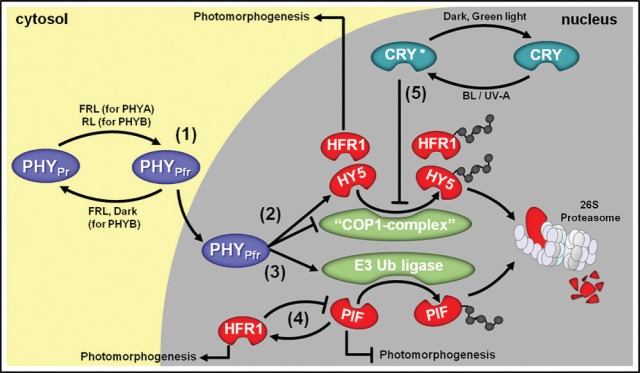FIGURE 1.

Simplified overview of light signal transduction via phytochromes (PHY) and cryptochromes (CRY) and their main interacting proteins. (1) Upon far-red light (FRL) or red light (RL) irradiation, cytosolic PHYAPr and PHYBPr, respectively, are converted into their active Pfr forms, which migrate to the nucleus. (2) In the cell nucleus, PHYPfr represses CONSTITUTIVE PHOTOMORPHOGENIC 1 (COP1) E3-complex (“COP1 complex”), which is responsible for targeting positive components of the light signal transduction pathway such as LONG HYPOCOTYL 5 (HY5) and LONG HYPOCOTYL IN FAR-RED 1 (HFR1) to proteasomal degradation. The expression of genes coding for HY5 and HFR1 is also promoted by PHYPfr and these transcription factors are responsible for stimulating the expression of numerous photomorphogenesis-associated genes. (3) In parallel, PHYPfr activates an unidentified E3 Ubiquitin (Ub) ligase responsible for targeting light signal transduction repressor proteins such as PHYTOCHROME-INTERACTING FACTORS (PIFs) to degradation via 26S proteasome. (4) PIFs are also known to stimulate HFR1 and HFR1 blocks PIFs transcriptional activity. (5) Upon blue light (BL) or UV-A exposure, nuclear-localized CRY is converted into active CRY*, which also repress “COP1 complex” action.
